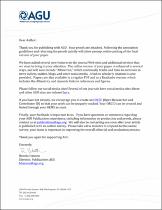 ResearchSpace
ResearchSpace
Observations of the vertical and temporal evolution of a Natal Pulse along the Eastern Agulhas Bank
JavaScript is disabled for your browser. Some features of this site may not work without it.
- ResearchSpace
- →
- Research Publications/Outputs
- →
- Journal Articles
- →
- View Item
| dc.contributor.author |
Pivan, X

|
|
| dc.contributor.author |
Krug, Marjolaine J

|
|
| dc.contributor.author |
Herbette, S

|
|
| dc.date.accessioned | 2017-07-28T09:10:53Z | |
| dc.date.available | 2017-07-28T09:10:53Z | |
| dc.date.issued | 2016-09 | |
| dc.identifier.citation | Pivan, X., Krug, M.J. and Herbette, S. 2016. Observations of the vertical and temporal evolution of a Natal Pulse along the Eastern Agulhas Bank. Journal of Geophysical Research: Oceans, 121(9), pp 7108-7122 | en_US |
| dc.identifier.issn | 2169-9275 | |
| dc.identifier.uri | http://onlinelibrary.wiley.com/doi/10.1002/2015JC011582/abstract | |
| dc.identifier.uri | http://hdl.handle.net/10204/9383 | |
| dc.description | Copyright: 2016 American Geophysical Union | en_US |
| dc.description.abstract | This study reinvestigates the work of Lutjeharms et al. (2001, 2003) who documented the properties of a Natal Pulse using isopycnal Lagrangian floats. We combined Lagrangian analyses and Eulerian maps derived from objective analysis to better describe the evolution of a Natal Pulse along three density surfaces referred to as the surface (satellite-observed), shallow (isopycnal 1026.8 kg m-3), and deep (isopycnal 1027.2 kg m-3) layer. Our observations show that this Natal Pulse extended to a depth of 1000 m and was associated with cyclonic relative vorticity values of about 6.5–8.5 × 10-5 s-1 in the surface and shallow layer and 4 × 10-5 s-1 in the deep layer. This Natal Pulse contributed to cross-shelf exchange through the offshore advection of Eastern Agulhas Bank water near the surface, onshore advection of South Indian Central Water and/or Indian Equatorial Water in the shallow layer, and Antarctic Intermediate Water in the deep layer. Sea surface temperature maps showed that the downstream progression of the Natal Pulse along the 3000 m isobath was related to a readjustment of its rotation axis. This readjustment advected Eastern Agulhas Bank water into the Natal Pulse eddy and triggered a SST cooling of about 3°C in the cyclonic area. The importance of a warm recirculating Agulhas plume originating from the Natal Pulse was highlighted. This warm water plume extended to a depth of 700 m and was associated with onshore velocities exceeding those experienced within the Natal Pulse eddy by a factor of 2. Our observations indicate that the June/July 1998 Natal Pulse and its associated plumes enhanced cross-shelf exchanges. | en_US |
| dc.language.iso | en | en_US |
| dc.publisher | American Geophysical Union | en_US |
| dc.relation.ispartofseries | Workflow;18548 | |
| dc.relation.ispartofseries | Workflow;18618 | |
| dc.subject | Geophysics | en_US |
| dc.subject | Natal pulse | en_US |
| dc.subject | Eastern Agulhas Bank | en_US |
| dc.title | Observations of the vertical and temporal evolution of a Natal Pulse along the Eastern Agulhas Bank | en_US |
| dc.type | Article | en_US |
| dc.identifier.apacitation | Pivan, X., Krug, M. J., & Herbette, S. (2016). Observations of the vertical and temporal evolution of a Natal Pulse along the Eastern Agulhas Bank. http://hdl.handle.net/10204/9383 | en_ZA |
| dc.identifier.chicagocitation | Pivan, X, Marjolaine J Krug, and S Herbette "Observations of the vertical and temporal evolution of a Natal Pulse along the Eastern Agulhas Bank." (2016) http://hdl.handle.net/10204/9383 | en_ZA |
| dc.identifier.vancouvercitation | Pivan X, Krug MJ, Herbette S. Observations of the vertical and temporal evolution of a Natal Pulse along the Eastern Agulhas Bank. 2016; http://hdl.handle.net/10204/9383. | en_ZA |
| dc.identifier.ris | TY - Article AU - Pivan, X AU - Krug, Marjolaine J AU - Herbette, S AB - This study reinvestigates the work of Lutjeharms et al. (2001, 2003) who documented the properties of a Natal Pulse using isopycnal Lagrangian floats. We combined Lagrangian analyses and Eulerian maps derived from objective analysis to better describe the evolution of a Natal Pulse along three density surfaces referred to as the surface (satellite-observed), shallow (isopycnal 1026.8 kg m-3), and deep (isopycnal 1027.2 kg m-3) layer. Our observations show that this Natal Pulse extended to a depth of 1000 m and was associated with cyclonic relative vorticity values of about 6.5–8.5 × 10-5 s-1 in the surface and shallow layer and 4 × 10-5 s-1 in the deep layer. This Natal Pulse contributed to cross-shelf exchange through the offshore advection of Eastern Agulhas Bank water near the surface, onshore advection of South Indian Central Water and/or Indian Equatorial Water in the shallow layer, and Antarctic Intermediate Water in the deep layer. Sea surface temperature maps showed that the downstream progression of the Natal Pulse along the 3000 m isobath was related to a readjustment of its rotation axis. This readjustment advected Eastern Agulhas Bank water into the Natal Pulse eddy and triggered a SST cooling of about 3°C in the cyclonic area. The importance of a warm recirculating Agulhas plume originating from the Natal Pulse was highlighted. This warm water plume extended to a depth of 700 m and was associated with onshore velocities exceeding those experienced within the Natal Pulse eddy by a factor of 2. Our observations indicate that the June/July 1998 Natal Pulse and its associated plumes enhanced cross-shelf exchanges. DA - 2016-09 DB - ResearchSpace DP - CSIR KW - Geophysics KW - Natal pulse KW - Eastern Agulhas Bank LK - https://researchspace.csir.co.za PY - 2016 SM - 2169-9275 T1 - Observations of the vertical and temporal evolution of a Natal Pulse along the Eastern Agulhas Bank TI - Observations of the vertical and temporal evolution of a Natal Pulse along the Eastern Agulhas Bank UR - http://hdl.handle.net/10204/9383 ER - | en_ZA |





